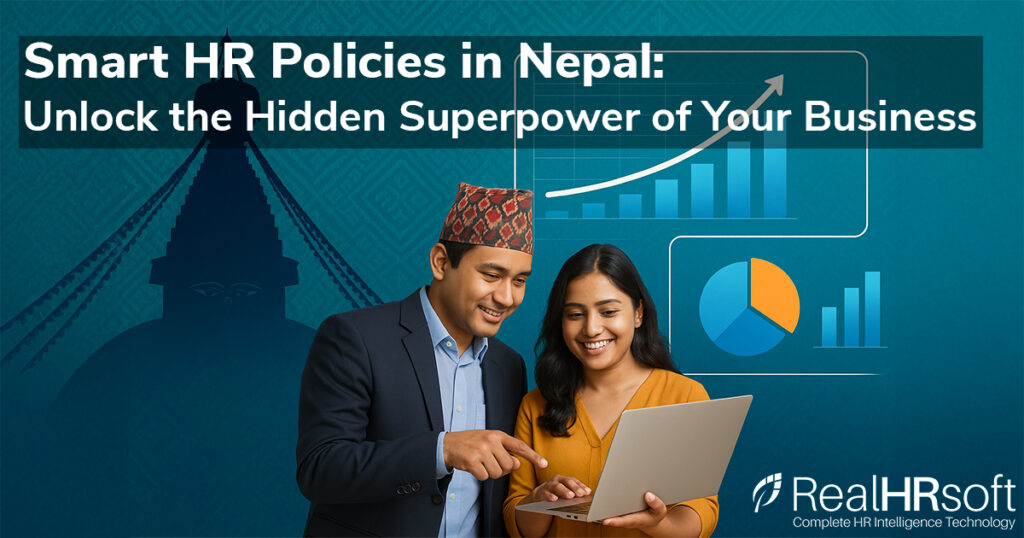Are You Ready to Inspire Greatness in Your Nepali Business?
In today’s fast-paced, ever-changing business landscape, especially here in Nepal, do you feel the pull of a grander vision for your organization? Is leading your team towards that future sometimes met with unexpected challenges? From navigating complex labor laws to cultivating a culture where every individual shines, the journey is profound. But what if we told you there’s a strategic secret weapon that can transform these challenges into unparalleled opportunities for growth and fulfillment, inspiring your Nepali enterprise to reach its highest potential?
The Inspiration Your Business Needs!
Beyond the daily tasks of hiring and payroll, Human Resources Management (HRM) is truly about sculpting the future of your organization. It’s about empowering people, fostering innovation, and building a legacy. And at its core? Well-defined HR policies. This isn’t just about adhering to rules; it’s about crafting the very soul of your workplace, ensuring your team is skilled, motivated, and adaptable – ready to embrace every challenge and opportunity the vibrant Nepali market presents.
- Do you envision a workplace of unwavering consistency and fairness?
- Are you determined to build a legally secure foundation for sustainable growth?
- Do you aspire to inspire loyalty and brilliance, ensuring your top talent thrives and stays?
If your heart resonated with any of these questions, then this guide is your blueprint! We’re about to unveil why robust HR policies are not just a necessity but the very spark that ignites your ultimate competitive advantage, paving the way for a truly inspiring Nepali business.
Why Smart HR Policies Are Your Business’s Canvas for Success
Think of HR policies as the strong foundation of your “ghar” (home, i.e., your organization). Without them, even the grandest vision can falter. Here’s how they empower your business, fueling both strategic aspirations and operational brilliance:
Strategic Superpowers – Building Your Legacy:
- Strategic Alignment: Your workforce strategies directly support and enhance overall organizational objectives. Imagine your team, from Kathmandu to Pokhara, all pulling in the same direction with a shared purpose, boosting productivity and efficiency!
- Talent Optimization: From attracting the brightest minds to nurturing their growth and celebrating their achievements, policies streamline your entire employee lifecycle. This means you attract and cultivate the “dai” and “bhai” (brothers) and “didis” (sisters) of talent who will passionately drive your business forward.
- Culture Building & Employee Engagement: Promote inclusivity, equality, and open communication. Foster a workplace where every employee feels valued, engaged, and motivated to contribute their best, building a strong “parivar” (family) within your company that attracts and retains top talent.
- Risk Mitigation & Legal Compliance: Navigate Nepal’s labor laws and regulations with clarity through clearly defined HR policies, protecting your organization from significant legal issues, financial penalties, and reputational damage. Stay compliant, stay secure, and build trust!
- Enhanced Decision-Making: Clear, consistent HR policies provide a framework for equitable and transparent decision-making across all levels of the organization. This fosters trust and stability, minimizing ambiguity and potential conflicts, allowing for decisive and confident leadership.
Operational Excellence – Nurturing Daily Brilliance:
- Clarity and Consistency: HR policies provide clear guidelines on employee behavior, organizational expectations, and individual roles. This helps maintain fairness and consistency in decision-making, creating a sense of trust within the workplace. No more guesswork, just smooth operations!
- Streamlined Processes: From recruitment to performance evaluations, HR policies create standardized and efficient processes. This reduces administrative burden, improves efficiency, and allows your HR professionals to focus on more strategic, people-centric initiatives.
- Effective Conflict Resolution: By establishing a structured process for addressing workplace conflicts, grievances, and disciplinary actions, HR policies promote a harmonious work environment and efficient resolution of issues.
- Improved Employee Relations: Transparent policies regarding compensation, leave, and performance management foster trust and open communication between employees and management, leading to improved employee relations.
- Resource Allocation: Policies around training and development, and employee recognition help organizations allocate resources effectively to enhance employee capabilities and motivation, truly investing in your human capital.
What Does a “Superpower” HR Policy Look Like? ✨
A comprehensive HR policy isn’t just a set of rules; it’s a living document that defines the aspirations and functionality of your organization. Here are the essential components that every aspiring HR professional and business house in Nepal should consider, each a brushstroke in your masterpiece of a workplace:
- Introduction and Purpose: This foundational section provides an overview of the organization’s vision, mission, and values. It explains the purpose of the HR policy and how it aligns with organizational goals to ensure a fair and supportive workplace.
- Hiring Policy: Details the recruitment process, including how job positions are created, how job descriptions are prepared, and the types of employment and recruitment. It also explains the steps in selecting a candidate, such as shortlisting, written tests, interviews, offering a job, and deciding on the joining date. Finally, it covers the steps after hiring, including signing the employment contract, collecting and verifying documents, and providing orientation.
- Employment Conditions: Explains the probation period for different employee types and the process of probation evaluation after joining.
- Attendance Policy: Defines working hours, holidays, and overtime conditions. It also specifies eligibility for claiming overtime and how attendance is tracked.
- Leave Policy: Lists the types of leave (e.g., annual leave, sick leave, maternity/paternity leave) and the process for applying for leave. It also identifies who approves leave requests.
- Compensation Policy: Outlines salary structure, including basic salary, allowances, retirement funds, gratuity, and other benefits like transportation or health checkups. It also explains provisions for salary increments, bonuses, and employee benefits like insurance. Additionally, it provides provisions for salary advances, including the eligibility criteria and repayment terms, if applicable.
- Travel Policy: Describes what qualifies as official travel, rules for travel, and how to apply for travel and claim expenses with the required supporting documents.
- Performance Appraisal: Provides the framework for evaluating employee performance, including the periodic review process and how appraisals are conducted.
- Promotion Policy: Defines the conditions and criteria for employee promotions, including career progression paths and eligibility for promotion. The policy also outlines how promotion decisions are communicated to employees.
- Training and Development Policy: Outlines the organization’s approach to employee development, including training opportunities and programs. It details how training needs are identified through performance reviews, employee feedback, or organizational goals to ensure relevant and effective development initiatives.
- Employee Recognition and Rewards: Describes methods for recognizing and rewarding employees, such as bonuses, awards, or public acknowledgment for achievements.
- Separation Policy (Offboarding): Covers types of separation, such as retirement, resignation, or termination. It explains the process for separation, including notice period requirements, exit interviews, and maintaining confidentiality after leaving the organization.
- Code of Conduct and Disciplinary Actions: Clarifies expected employee behavior and outlines the types of misconduct that may lead to disciplinary actions, including warnings, suspension, or termination.
- Harassment Policy: Defines what constitutes harassment and explains the process for reporting and addressing such issues by ensuring confidentiality and protection for whistleblowers.
- Grievance Policy: Provides clear steps for employees to report grievances and how the organization will handle and resolve them. It includes timelines and escalation procedures.
- Health and Safety Policy: Describes the organization’s efforts to ensure a safe work environment, including health and safety guidelines and support for employee wellness programs.
Build Your Unstoppable HR Framework with RealHRsoft! ️
Developing these policies might seem like a monumental task, but with a structured, collaborative, and inspired approach, it’s entirely achievable. Here’s a simplified roadmap to ignite your HR excellence:
- Assess Your Needs: Deeply understand your current workforce, identifying existing gaps and pinpointing areas that cry out for new policies or thoughtful adjustments. Envision the future needs of your organization in terms of growth and changes.
- Define Structure: Clearly map out your departments, roles, and reporting relationships to ensure policies align with the organizational hierarchy.
- Research & Benchmark: Explore industry best practices, compensation trends, and performance evaluation methods within your specific sector. Ensure your policies are competitive and attractive to talent, inspiring the best to join your mission.
- Engage Stakeholders: Involve your senior management, department heads, legal teams, and most importantly, your employees! Their diverse perspectives are invaluable for crafting policies that are practical, legally compliant, and truly aligned with your organizational goals.
- Understand Legalities: Collaborate closely with legal counsel to familiarize yourself with local labor laws, employee rights, health and safety regulations, and data protection rules. This is crucial for building a secure foundation and avoiding future “jhamela” (trouble)!
- Align with Culture: Ensure policies reflect and reinforce your organization’s mission, vision, and core values. Design policies that support and enhance the company’s work environment and foster high employee engagement, reflecting the true spirit of your Nepali workplace.
- Set Clear Objectives: Define the specific purpose of each HR policy. Set SMART (Specific, Measurable, Achievable, Relevant, and Time-bound) objectives to guide the drafting process and ensure policies are targeted and truly effective.
- Identify Key Areas: Prioritize areas requiring new or updated policies based on urgency, impact, and strategic importance, ensuring nothing is overlooked in your quest for excellence.
- Plan Communication: Develop a comprehensive plan for how policies will be communicated to all employees to ensure a smooth adoption and understanding across the organization. Training is key to empowerment!
- Allocate Budget: Secure the necessary resources (time, personnel, financial budget) for policy creation, communication, and ongoing implementation. Investing in your HR framework is an investment in your future.
HR Policies vs. Employee Handbooks: Know the Difference, Embrace Both!
While often used interchangeably, these two serve distinct yet complementary roles, each vital for a thriving organization:
- HR Policies: These are the formal, overarching guidelines, the “constitution” of your HR function. They are strategic, designed to ensure legal compliance, and primarily for HR professionals, managers, and legal teams to guide their actions and decisions.
- Employee Handbooks: This is the user-friendly guide for all employees, translating those complex policies into clear, actionable terms. It’s the “rulebook” everyone can easily understand and reference for their day-to-day work life, serving as a primary communication tool. Employees are usually required to acknowledge receipt and understanding, which can serve as legal protection.
Both are indispensable for consistency, legal protection, strategic alignment, talent management, and most importantly, for fostering a truly positive and inspiring work environment. Together, they form a robust framework for managing human resources effectively, ensuring both organizational success and employee well-being.
Ready to build a legally compliant, highly engaged, and truly inspiring workforce in Nepal?
RealHRsoft is your dedicated partner in this transformative journey. Our HR software Nepal and Human Resource Software Nepal solutions empower visionary businesses like yours to implement, manage, and optimize your HR policies with unparalleled ease. From payroll software Nepal and attendance management system Nepal to HR analytics software Nepal and Nepal HR software with ESS (Employee Self-Service), we provide the cutting-edge digital HR tools for Nepali companies to simplify your HR, allowing you to focus on what you do best – nurturing your team and achieving your grandest business goals.
Don’t just manage HR, inspire it!
Visit www.realhrsoft.com today to learn more and see how RealHRsoft can help your Nepali business not just thrive, but truly inspire.



